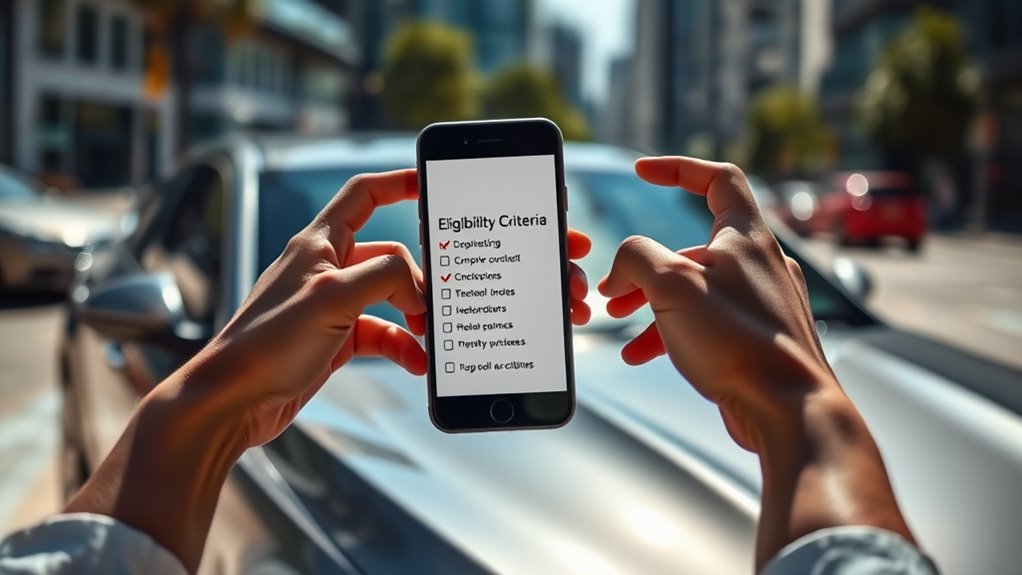Have you ever wondered what makes you eligible for non-owner car insurance? Understanding the key criteria can help you navigate this often-overlooked aspect of car insurance. Factors like your driving record, financial responsibility, and even your age play a significant role in determining your eligibility and rates. Knowing these can save you both time and money, but there's more to weigh when evaluating your options. Let's explore the essential criteria further.
Key Takeaways
- Must have a valid driver's license and a clean driving record to qualify for non-owner car insurance.
- Regularly drive rented or borrowed vehicles, indicating a need for liability coverage.
- Meet state-specific insurance requirements, including minimum coverage limits for non-owner policies.
- Be prepared to provide proof of financial responsibility if required, such as an SR-22 form for serious offenses.
- Age, gender, and credit score may affect eligibility and insurance premium rates for non-owner car insurance.
Driving Frequency and Usage Patterns

When you frequently drive but don't own a vehicle, understanding your driving frequency and usage patterns becomes essential for determining if non-owner car insurance is right for you.
Understanding your driving frequency and patterns is crucial for deciding if non-owner car insurance suits your needs.
If you often rent cars or borrow from friends outside your household, this insurance can provide valuable coverage. It's particularly beneficial for high-mileage driving or intermittent needs, like weekend trips. Additionally, this type of insurance provides liability protection when driving borrowed or rented cars, ensuring you're covered in case of an accident. Non-owner car insurance can also offer additional peace of mind when you are using someone else's vehicle, as it ensures that you are covered for damages and liability.
If your job requires regular use of borrowed vehicles, non-owner insurance is advisable. Additionally, if you use car-sharing services frequently, this type of policy can guarantee you're protected.
However, if a household member already owns a vehicle that you're covered under, you may not need this insurance.
Evaluate your driving habits to make an informed decision.
Financial Responsibility Verification
To confirm you're meeting legal requirements while driving without owning a vehicle, it's crucial to understand financial responsibility verification. This process guarantees you carry the minimum liability insurance required by your state.
Here's what you need to know:
- You must provide proof of liability insurance upon request, such as during vehicle registration or traffic stops.
- An SR-22 form may be necessary if you've had serious offenses that require financial responsibility verification.
- Certificates of financial responsibility can be issued by state authorities, confirming you meet the required standards.
Understanding State Requirements
Understanding state requirements for non-owner car insurance is essential, especially if you plan to drive frequently without owning a vehicle. Each state has specific laws, and states like Illinois impose strict penalties for driving without insurance.
For example, Illinois mandates minimum coverage limits of $25,000 for bodily injury per person, $50,000 per accident, and $20,000 for property damage. If you've had your license suspended, you often need to show proof of insurance to reinstate it.
Additionally, those requiring SR-22 certificates due to major infractions may need a non-owner policy to demonstrate financial responsibility. By securing non-owner insurance, you guarantee compliance with state laws, particularly if you frequently borrow cars.
Assessing Risk Factors

Evaluating risk factors is essential for determining non-owner car insurance rates, as various elements can influence your premium. Key considerations include:
- Age and Gender: Younger drivers and males typically face higher rates due to increased accident likelihood.
- Credit Score: A good credit score can lower premiums, while poor scores often lead to higher costs.
- Driving History: A clean driving record will usually result in lower rates compared to those with accidents or violations.
Understanding these factors helps you anticipate your insurance costs and make informed decisions.
Coverage Gap Considerations
While managing periods without vehicle ownership, it's important to contemplate how non-owner car insurance fills potential coverage gaps. This type of coverage maintains continuous insurance, which can help prevent premium increases when you eventually buy a new vehicle.
By avoiding coverage gaps, you lower the perceived risk for future insurance purchases, minimizing your financial risk if an accident occurs between ownership periods. Gaps can classify you as a high-risk driver, leading to higher premiums.
Non-owner policies are usually more affordable than rental insurance and provide necessary compliance with state laws. They typically cover bodily injury and property damage liability while offering the option of uninsured/underinsured motorist coverage, making them a smart choice during ownership gaps.
Conclusion
To sum up, when you're considering non-owner car insurance, focus on fulfilling fundamental factors like a valid license, clean driving record, and financial responsibility. Remember to review state requirements and assess your specific risk factors. By addressing these aspects, you can secure sensible coverage that suits your needs. Don't let gaps in guidance guide you astray; staying informed can save you stress and dollars down the road. Stay smart, stay safe, and drive with confidence!

